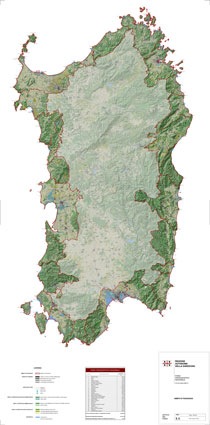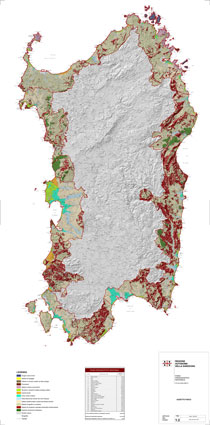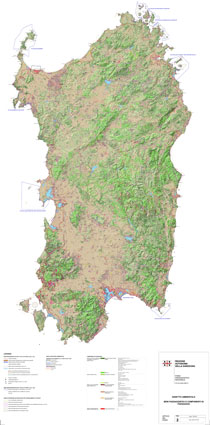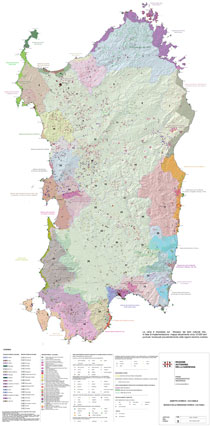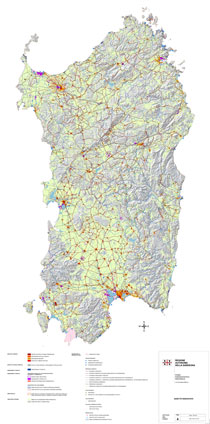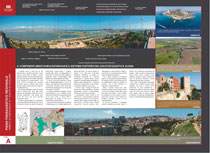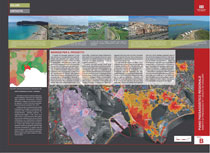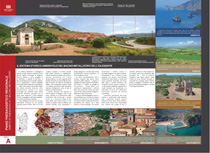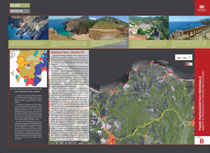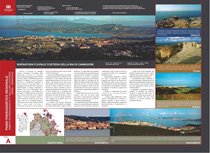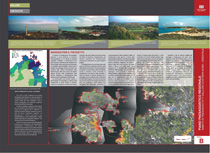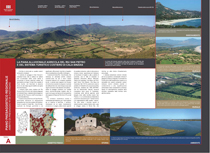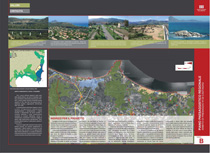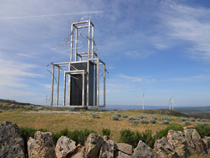Sardinia and Sustainability. Between saying and doing… Cesarina Siddi 
Landscape and sustainability are the key concepts that characterize all new governmental policies, from European Union to local Administrations, and all territorial actors are engaged in experimenting their operational meanings. The two concept are often related in the contemporary debate, both theoretical and operational, but these relationships are too often more formal than essential. Certainly they are two “open” concepts, and it’s for this reason that it’s hard to develop their operational meaning and even more the meanings of their mutual relationships. The unvarnished paradox is that sustainability has moved from being the founding and essential requirement of all ancient territorial cultures (i.e. the oasis as paradigmatic settlement…), to being a concept that we have to re-define and re-appropriate. Sardinia reflects perfectly this situation not so much in policies that, especially during last decade, have demonstrated a real commitment in fostering opportunities to express the concept through accomplished facts, as in actions, still too often projected to a cruel destiny as “lost opportunities”. The history of Sardinian built environment is ancient and rich in articulated and deep relations between territory and community, between residential and productive landscapes, complex geographies on which modernity has often acted mercilessly…
The new national interest in preservation of architectural heritage developed since the eighties of last century, stimulated also in Sardinia a new awareness of historical and cultural landscape.
The first law on this subject is the L.R. n. 29/98 “Preservation and enhancement of historical centres”: the restoration, rehabilitation and reuse of historical centres and villages, being respectful of sociocultural, historical, architectural, urban, economical and environmental values, are priorities of Autonomous Region of Sardinia.
In the ensuing years various programmes and actions came from this law, and they are important to explain the (difficult) path towards sustainability.
In 2004 Autonomous Region of Sardinia (as leader partner) promoted LAB.net, EU Project – Interreg IIIA, developed with other Sardinian Local Authorities (Province of Sassari and Nuoro, various Municipalities) and partners from Tuscany and Corsica.
The aim was to enhance the historical architectural heritage of these cross-border territories encouraging sustainable development through making the best use of natural and cultural resources.
In Sardinia this programme set up five laboratories for the rehabilitation of historical centres and interventions in thirty Municipalities, favouring the rediscovery of traditional knowledge in architecture and building and the development of new relations between tradition and innovation.
As a natural continuation of it, in 2007 Autonomous Region of Sardinia started up “LAB.net plus – Cross-border network for the enhancement of landscapes and local identities”, in the framework of “Cross-border Cooperation Operational Programme: Italy – Maritime France” co-financed by the European Regional Development Fund (ERDF) under the European Territorial Cooperation Objective, (Axis 4 -' Integrating Resources and Services'). This project offered an opportunity to define and implement tools useful in spreading knowledge and awareness to the communities involved towards preservation and the enhancement of landscapes and local identity, and it shows an important change of perspective: Sustainability and Landscape are explicitly related. “Landscape has to be considered as common heritage, and for this reason each action on it has to be informed by sustainability, avoiding every kind of irreversible processes.” The methodology was founded on participation, locally were set up “Territorial aerials” charged with interpreting needs and expectations of different territories and interacting with the “Regional design office” (charged with design coordinating).
During LAB.net another important experience: the drawing up of the Regional landscape Plan (PPR), the first in Italy after the promulgation of the “Code of the Cultural and Landscape Heritage” (L. D. n. 42/2004). The key concept of the Plan is that landscape, whose character is the result of the action and interaction of natural and/or human factors, has to be the first and most important resource for the future of the Island. Through the first part, concerning coastal environment municipalities and approved in 2006, Sardinia started up developing one of the most innovative policy for protection and enhancement of coastal environmental heritage, attacked in the last decades by the pressure of Tourism and speculative building. Due to these aggressive actions, the coastal system has been totally transformed, sometimes in an irreparable way. This phenomenon (caused by “Costa Smeralda effect”) created the serial repetition of touristic settlements totally indifferent to local values and characters and, at the same time, contributed to divert the attention from internal landscape.
A sustainable future for these internal territories is the subject of another regional programme, “CIVIS – Strengthening small urban centres”, Regional Operational Programme for Sardinia -2000-2006 - Priority 5: Cities. CIVIS is an initiative that promoted “quality pilot projects” for the rehabilitation of historical urban centres and was addressed to cooperative networks of at least five municipalities (or three but with a total population of at least 10000 inhabitants). Its main goals are consistent with the concept of sustainability, but it is lacking in giving a clear definition of sustainable design. This fact is confirmed by evaluation criteria: just 7/100 for environmental quality of design, and just 6/100 for innovation in design.
In 2008 BIDDAS, another regional programme for reinforcing the process of enhancement of historical architectural heritage of small urban centres applying the policy of PPR
Also in this programme the invite to “experiment new spatial models for a correct environmental and landscape configuration” has been partially disappointed: good quality of projects in terms of contemporary architectural language but not enough attention to sustainability as founding principle of innovative design.
Another initiative to better understand the situation: since 2007 the “Regional Landscape Award. Ideas Competition for quality landscape and environmental sustainability interventions and landscape photography”.
The competition is interesting because it declines different categories for interventions, inviting to develop the concept of sustainability through different design subjects, but… reading the evaluations of the jury for the last edition: sustainability has been considered just in terms of “respect for historical and symbolic values”!
At this point this is the question: does contemporary Sardinian architecture leave sustainability out of consideration?
Looking at an interesting research being done by IN/ARCH Sardegna “EMERGING QUALITY/RECENT ARCHITECTURE IN SARDINIA” we can find fifteen good projects but, once again, without a structural use of sustainability principles.
Back again to 2007 for another regional action: “COSTERAS. Ideas Competition for the rehabilitation of eight coastal villages in Sardinia”. The competition aimed to apply the objectives, policy and criteria of PPR to these places: the announcement asked to draw attention to compatibility of design and landscape characters, environmental sustainability and energy saving.
In 2009 the Regional Government offered economic contributions to municipalities through the competition “LITUS – Interventions of natural and landscape restoration and rehabilitation of damaged coastal areas”. The initiative was strongly oriented towards environmental sustainability, especially through an appropriate use of local traditional materials and technics, as well as of native plant species.
In 2010 "Coastal Architectural Projects – Design projects for seaside facilities", a competition promoted by Regional Government to highlight the special value of the seaside as an economic resource as well as a fragile heritage to protect. The announcement invited designers to involve producers, citizens and other stakeholders to fulfil all the aims: diversifying the touristic strategy interpreting the cultural identity and activating relations with the different territorial characters (natural, rural or urban); using renewable energies; experimenting design innovation.
In the meantime, Sardinia has become active in another important theme: climate and energy.
In 2009 Regional Government published the first Guidelines (consistent with PPR) about suitable areas and requirements for the installation of the different renewable energy systems.
Moreover the Island is strongly participating in Covenant of Mayors: at the moment, 183 Municipalities out of 377 (1040057 inhabitants out of 1637846, 63.5 % of total population), 144 Municipalities submitted the Sustainable Energy Action Plan (659815 inhabitants, 40.3% of total population) and 23 of these are coastal Municipalities (359582 inhabitants, 21.9 % of total population).
Some of these Plans have been considered as “benchmarks of excellence” but none of these examples shows a clear intention to use energetic sustainability to improve urban and landscape quality.
Three main problems affect the theme.
The first one is the misunderstanding of thinking that using renewable energies and reaching CO2 reduction could be decisive actions to deal with sustainability.
The second one is that still too often the installation of energy systems is not considered as architectural and landscape design theme.
The third one is that the potential of activate synergies between SEAP and other kind of Plans (first of all Urban Plan) is not enough clear.
Due to these problems, in Sardinia we can recognize an increasingly serious critical state: government’s incentives for solar power have favoured the requests for authorization to install photovoltaic systems on residential buildings, but most Building Regulations don’t provide for this subject and the authorization procedure is really long so that we can find a lot of unlawful installations. This situation risks seriously compromising buildings and urban fabrics, first of all in historical urban centres.
About large-scale installations the regional context highlights two interesting situations.
The first one is about photovoltaic in agricultural areas.
Agriculture represents an ancient productive sector, which has strongly influenced Sardinian identity even if it has never overcome the status of “subsistence economy”. Agricultural policies addressed to improve competitiveness have ever been a regional priority.
In the Guidelines it’s clear the aim to avoid speculation and to promote new forms of competitiveness for agriculture: favouring multi-functionality (allowing a supplementary income for farmers) and reducing production costs (i.e. greenhouses heating and cooling).
Moreover photovoltaic installations are allowed only on productive greenhouses and energy services have to be managed by farmers or by a joint venture where farmers hold the majority of the shares.
Sardinia has been the first Italian region to legislate for Solar PV Greenhouses, and a year later (in 2011) the first Solar PV Greenhouses Park has been inaugurated in Villacidro (25 km from Cagliari):
“Su Scioffu” is a 20MW Solar PV farm built on a 27,000 m2 area and it is the world's largest one.
In the meantime other Solar PV farms are being built, but even now this subject generates heated debate: it is widely believed that there's a high risk of speculation without enhancing local agricultural economy.
The second one is about wind power systems.
The Autonomous Region has completed the legislative framework with specific studies about this kind of installations.
The PPR provides that it’s not allowed to install wind power systems on the following areas:
- Natural and sub-natural areas;
- Semi-natural areas;
- Natural and protected areas;
- Historical areas and settlements.
The suitable areas are those defined as damaged, industrial and retro-industrial, as well as their neighbouring zones.
Also this subject generates heated debate: in this case besides the risk of speculation, the social acceptability is a key factor.
Most people consider visual impact of wind power installations strongly negative and they think that turbine construction will inevitably affect the local environment, probably destroying it.
About the Island’s largest wind farm there is an interesting experiment promoted by the Municipality.
The wind farm of Larenzu is in the municipality of Ulassai (a little village of Ogliastra), built on a 2900 hectares area (one of the most windy places in Italy) far 10 km from settlements, has 48 turbines and produces 180 GWh per year. Municipality invited Maria Lai, one of the most important Sardinian artist (she has died recently, on April 16th 2013) and native of Ulassai, to create a work to improve the social acceptability of the wind park. She answered creating “Catching the wings of the wind”: among the “Flowers of the sky” she created a steel mask representing the god of wind, on a base of approximately 3 metres, and almost 10 metres high.
Since 2009 it’s the turn of a god of steel to reconcile people with technology… but the poetry begins with the turbine’s blades like flowers in the sky helping the soul to listen to new forms.
The last important programme about climate/energy is “Smart City – Municipalities energy rating A”, promoted by Regional Government in 2011 as a part of the programme “Sardegna CO2.0”.
Smart City had the aim to select some virtuous municipalities (“Pioneer Communities”) for supporting them with technical assistance and financial incentives. These municipalities will have to prepare their Sustainable Energy Action Plan (SEAP) together with the Baseline Emission Inventory within 7 months, and then they will have supplementary incentives.
The selection process was completed 22 March 2013, and one of the selected “Pioneer Community” is Villagrande Strisaili, an active municipality in developing best practice in environment and sustainability.
Villagrande Strisaili is a municipality of Ogliastra, it has about 3800 inhabitants and a total area of 210 km2. In 2010 this Municipality started the project “Supply chain for Sustainable Building” with the aim of encouraging the adoption of virtuous behaviours in the building sector (especially about quality and quantity of raw materials, waste production and reuse, energy efficiency, renewable energy) through improving the consciousness of local authorities, the competences of building enterprises on “eco-building” and the awareness of citizens.
The project was promoted by Town Councillorship for Production Sector, Agriculture, EU Policies, Commerce and Handicrafts, with the partnership of the Municipalities and of the Province of Ogliastra, and financed by Regional Councillorship for Environmental Protection.
Domenico Bianco, Architect and Scientific Coordinator, well explains the project philosophy: “The project is addressed to all the territory of Ogliastra, characterized by an extraordinary landscape, and the aim is to combine the development of this territory with the improvement of life standards and environmental quality.
We are aware that the increasing pressure of Tourism binds us to develop strategies to protect and enhance this landscape. Nature is the first resource and the building activity could compromise it in an irreversible way. For these reasons our work tries to give answers to the requirements of territorial development through good practices in Architecture, Urban design and also Daily Life.”
The project has been developed in a year through two kinds of activities: on the one hand a complete survey of all Sustainable Building Regulations now operating in Italy, on the other hand the organization of working groups composed by various stakeholders (administrators, architects and engineers, builders, producers and, above all, citizens) coming from all the territory of Ogliastra.
The output of the project consists of four documents: a detailed Report on methodology, an Informative Booklet addressed to common people, a Regulation on Urban Sustainability (“Then criteria about Urban Sustainability) and a Prototype of Sustainable Building Regulation.
The last two tools are the most important and they are structured as “documents ready to be dismantled”: a clear and simple style of writing helps stakeholders to adapt the Prototypes to their expectations and to their territorial specificities.
It’s really interesting the methodology used to define the structure of the “Prototype”.
The research has been structured around five subjects:
- Context
- Building envelope performances
- Energy efficiency
- Renewable energies
- Environmental Sustainability
“Study reports” have been drawn up about each important topic of the five subjects, and they have been perfected and completed highlighting the following aspects:
- Description of the issue
- Hints to deal with the issue
- Repercussions on psycho-physical well-being and comforts
- Repercussions on environmental qualities
- Possible correlations between the issue and other ones
- Descriptions of expected performances
- Regulations, legislative and technic frameworks
- Hints to deal with economic incentives and derogations of Urban Planning rules
So the Prototype is structured around the same five subjects of the analysis:
- Context: environmental protection and site analysis for a good design.
- Building envelope performances: improvement of the characteristics of building envelope to improve energy consumption and comforts.
- Energy efficiency: improvement of the performances of energy system.
- Renewable energies: totally or partially successful in fulfilling primary energy demand of buildings respecting the environment.
- Environmental sustainability, reuse and recycle: local natural resources conservation and reduction of the environmental load.
Each subject is described taking into consideration the following points:
- Description of the issuema ti racconterò
- Hints to deal with the issue
- Repercussions on psycho-physical well-being and comforts and repercussions on environmental qualities
- Descriptions of expected performances
This work was presented in 2011 at the second edition of “Sustainable Production Fair – Building, producing, living and healthy eating”. This event is the first of its kind in Sardinia and it is an important part of the project.
“Supply chain for Sustainable Building” definitely represents the most significant experience to close this story about Sardinia and Sustainability.
Its output represents a very important tool to help Local Authorities and all stakeholders in improving their sustainable actions. Thanks to it, Sustainability in the next story about Sardinia probably will have found (again) its right role in architecture, territory, environment and landscape: not only saying but also finally doing…
